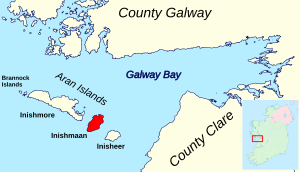Inis Meáin
| Inis Meáin Inishmaan |
||
|---|---|---|
| Location of Inis Meáin | ||
| Waters | Atlantic Ocean | |
| Archipelago | Aran Islands | |
| Geographical location | 53 ° 5 '0 " N , 9 ° 35' 0" W | |
|
|
||
| surface | 9.12 km² | |
| Highest elevation | 79 m | |
| Residents | 157 (2011) 17 inhabitants / km² |
|
| main place | To Córa | |
Inis Meáin [ ˌɪnʲɪʃ ˈmʲɑːnʲ ] ("middle island", older spelling Inis Meadhóin , Anglicised Inishmaan ) is an island in the Republic of Ireland . It belongs to the Aran Islands , which are in Galway Bay and belong to County Galway . With 912 hectares, it is the second largest inhabited and centrally located of the three main islands of this group of islands. The island is divided into two townlands ; Carrowntemple in the west and Carrownlisheen in the east.
157 people live on Inis Meáin (as of 2011). Tourism is less noticeable on Inis Meáin than on the neighboring islands of Árainn and Inis Oírr . The island is an important center of traditional Irish culture. It is in the Gaeltacht region, which means that the Irish language is the main language of the islanders.
Gregory's Sound , which separates the islands from each other, runs between Inis Meáin and Árainn . Inis Meáin can be reached by boat from Árainn as well as from Doolin and Galway , where there is also a flight connection. The main town of the island is An Córa , where the port of Inis Meáin is also located.
Inishmaan is considered the quietest and most tranquil of the Aran Islands. John Millington Synge already appreciated the calm and inspiring atmosphere.
On the island are the remains of three wedge tombs . Two are in the Carrownlisheen district (one of which is the National Monument known as "Leaba Dhiarmada is Ghrainne"). A badly disturbed one is in Carrowntemple, on the west side of the island.
Attractions
- Dún Chonchúir or Doonconor , an oval dun ( stone fort ).
- Dún Fearbhaí a stone fort from the 4th century. Its specialty is the approximately D-shaped construction, which differs from the round or semicircular duns on Inishmore.
- Teach Synge ( Synge's Cottage ), the house in which John Millington Synge (1871-1909) spent the summer from 1898-1902. It has been restored to its original state and has been open to visitors since August 1999.
- Cathaoir Synge ( Synge's Chair ), author 's favorite place on Inishmaan.
Individual evidence
- ↑ Table No. 11 Population of inhabited Islands off the coast, 2006 and 2011 . In: Central Statistics Office (Ed.): Population Classified by area . Dublin 2012, pp. 132-133 ( PDF file; 3.64 MB ( memento of October 10, 2012 in the Internet Archive ))



